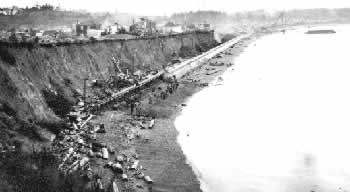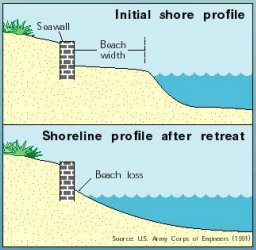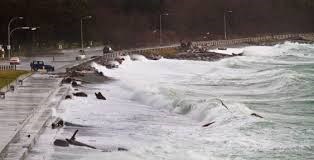To log this Earthcache please E-mail me the answers through my geocaching.com account. Once you've sent the email with your answers, go ahead and log your find without waiting for a reply from me. I will contact you if there are any problems with your log entry. Please do not give away any answers in your log or your photos!
Questions:
- Which kind of sea wall do you think this is, dissipative, reflective, or both? In your own words, please explain your answer.
- Look at the first 2 photos on the cache page to get an idea of what the beach looked like when the wall was being built so you have something to compare to. Describe what the beach in front of the sea wall down to the water looks like on the day you visited. Has the sea wall and groynes affected the beach?
- Has this sea wall had an issue with over topping? Provide your evidence. And if so how has it been dealt with?
- Is the sea wall protecting the property landward of the sea wall during normal conditions? How do you think it fares during storm conditions?
- Are the groynes here submerged or partially submerged? (I am aware that answers will vary due during storms and seasons) If you see the groynes during your visit, please tell me the approximate size of the material they are made up of.
Until 1911 the cemetery extended all the way to the beach of Ross Bay and some graves were located very close to the shoreline. Dallas Road ran from Beacon Hill but ended when it reached what is now Memorial Crescent on the west side of the cemetery. Memorial Crescent was a narrow street called Lover's Lane which connected to Fairfield Road. For many years before the sea wall was built, there were stories of coffins floating out to sea and children playing with the bones of people whose graves had been washed away by the storms. In 1909 violent storms washed away much of the shoreline of Ross Bay as well as large portions of the bank along sections N and L (mostly Chinese and Japanese, and First Nations peoples, were buried in these sections) of Ross Bay Cemetery.
The City decided to build a concrete wall along Ross Bay and extend Dallas Road. Some graves were relocated and the Chinese community moved as many remaining Chinese burials as possible to the Chinese cemetery at Harling Point.
 Building the cemetery sea wall along Dallas Road 1911
Building the cemetery sea wall along Dallas Road 1911
 Cemetery sea wall completed 1912
Sea Walls
Cemetery sea wall completed 1912
Sea Walls
Sea walls are constructed to protect coastal property from erosion by waves and sea level rise. Sea walls are typically large vertical or near vertical concrete structures built along long stretches of shoreline designed to either adsorb the waves energy or reflect the waves back out to sea. Sea walls that adsorb the wave energy are usually sloping, rough, and porous. Sea walls that are designed to reflect the wave energy are vertical or curved. These structures are effective at protecting the property landward of the sea wall, for a time and they need periodic maintenance.
The typical 3-foot high sea wave hits the sea wall with approximately 10 kilowatts of energy per meter of shore line. That is comparable to the power of a small car at full speed. The energy of a 9-foot wave is 10 times that (100 kilowatts). If a 45-foot wave ever came into the bay the energy would be 250 times the 3-foot wave. Waves of that height can be formed by a storm with 70 mph winds. Sea walls must be built to withstand a constant pounding from a lot of energy.

Sea walls immediately affect the beach profile. Sea walls are built where the coast line is eroding. Since the sea wall removes the source of sediment from the landward side of the beach, the waves erode the beach material instead. Additionally, the waves that reflect off the sea wall set up an interference pattern with the incoming waves creating waves that are larger and even more powerful. The result is that the beach is eroded and the foundations of the sea wall might begin to be eroded.
No matter how high the sea wall is constructed, there are storms where the waves go over the top of the wall and build up behind the wall. The sea wall built at side walk level has slits all along the bottom. The water that has come over the top of the wall can get back to the ocean through these slits instead of seeping into the ground and under the sea wall. If water did seep behind the wall, the foundations of the wall would be slowly eroded.
To protect against seepage erosion and the reflected waves eroding the foundations of the sea wall, additional armoring at the sea wall base is required. The possibility of over topping increases as sea levels rise, land subsidence, and the intensity of storm surges. The sea walls have to content with these conditions. Sea levels have been rising and continue to rise.
Armoring was completed a few years ago. From the sea wall right out into the middle of the bay, tons of gravel were added. This created a steeply sloped beach. Wave action has created natural steps in the gravel slope. Winter storms toss the gravel and tiny bits of drift wood up and over the wall, but not the great big logs, they now stay on the ocean side of the wall. Dallas Road is no longer closed during winter storms.

Advantages
Protects the base of cliffs, land and buildings against erosion. Can prevent coastal flooding in some areas.
Disadvantages
Expensive to build. Curved sea walls reflect the energy of the waves back to the sea. This means that the waves remain powerful. Over time the wall may begin to erode. The cost of maintenance is high.
 Ross Bay on a stormy day
Ross Bay on a stormy day
Groynes
A groyne is a rigid structure submerged or partially submerged in a body of water. It disrupts the natural water flow and limits the movement on sediment. Groynes are generally made of wood, concrete or rock piles and are placed in groups. In the ocean groynes create beaches or prevent them from being washed away by longshore drift. In a river groynes prevent erosion and ice-jamming, which aids in navigation. Ocean groynes generally run perpendicular to the shore and extend from the upper foreshore out into the water. If the entire groyne is located underwater, it is called a submerged groyne. The areas between groups of groynes are called groyne fields.
Advantages
Prevents the movement of beach material along the coast by longshore drift.
Allows the build up of a beach. Beaches are a natural defense against erosion and an attraction for tourists.
Disadvantages
Can be seen as unattractive.
Costly to build and maintain.
 Ross Bay on a calm day
Ross Bay on a calm day